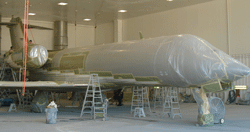Contributed by George Bajo, Completions Sales Rep.

An aircraft kept in a quality coat of paint is less likely to develop corrosion.
The longevity of an aircraft paint finish depends on several factors. The paint process, technician experience, product durability, regular maintenance and environmental conditions all affect how well the finish wears.
Although well-maintained, quality paint finishes can look immaculate for more than a decade, they are susceptible to damage. Chips from debris and cracks along seams, screw heads and rivets are inevitable and become more numerous as a finish ages. These are points of entry for moisture, which increases the potential for corrosion. Additionally, how an aircraft is stored, how often it’s flown per year, where it’s flown and what conditions it flies through can also affect the lifespan of a paint job.
Protecting a paint finish from heat, UV damage, moisture, salt and other environmental contaminants can help it last longer. Hangaring an aircraft for long-term storage, cleaning it frequently and thoroughly, conducting regular visual inspections, and touching up chips and cracks on a regular basis are all practices I highly recommend. Finishes that aren’t regularly maintained won’t last as long, and will be at higher risk of corrosion.
Will an aircraft develop corrosion if it’s not repainted according to manufacturer recommendations? It varies. An aircraft kept in a quality coat of paint is less likely to develop corrosion, but there is no process or product that can assure complete corrosion prevention. For this reason, aircraft should be stripped, inspected for corrosion and repainted by a reputable aircraft paint facility on a regular basis.
How often an aircraft needs to be repainted is really the operator’s decision. If the paint finish is regularly and meticulously maintained, the aircraft isn’t flown frequently or through adverse weather, and it’s properly stored, an aircraft might be able to go for longer periods between paint jobs. But it is a risk.
Duncan Aviation provides complete, custom paint refurbishment and completion services. Our refined paint process prolongs the lifetime of these finishes, protecting an aircraft from the elements for years. Modern paint booths produce a very high quality product, and are environmentally conscious. We offer a three year/1,500 hour warranty on exterior paint finishes.
For more information about Duncan Aviation’s paint refurbishment services, please visit www.DuncanAviation.aero/paint.
George Bajo is a Completions Sales Representative at Duncan Aviation-Battle Creek, specializing in interior and paint refurbishments for Bombardier, Embraer and Gulfstream aircraft. He began working in aviation in 1984.


